Last Updated on
When it comes to wildlife, lawns are a great place to start. Getting them right can dramatically increase the quantity of wildlife in your garden, helping you support nature and the natural world.
But knowing how to turn your lawn into a wildlife haven isn’t common knowledge. While it is perfectly possible, it remains something only a minority of people do.
Fortunately, this post can help. We take a look at all the techniques and strategies you can use to increase biodiversity in your backyard and give nature a helping hand.
Here’s what you need to know:
Avoid Pesticides And Herbicides
The first thing to do is to avoid using any pesticides or herbicides on your lawn. These can harm wildlife tremendously by reducing food sources and preventing biodiversity from developing.Remember, some weeds are actually good weeds because they increase the range of plants available to critters and insects in your back garden. If you need to remove plants because they are growing too much, pull them out of the ground by hand and throw them in the compost.
Create Shelter And Nesting Areas
Another great strategy is to add shelters and nesting areas to your lawn area. Aside from a beautiful patch of grass, you want birdhouses, insect hotels, and a variety of habitats.
The best way to get these into your garden is to make them yourself. However, you can also buy them ready-made to a high standard which will hopefully attract more creatures to your garden.
Create Borders And Beds
You don’t need to eliminate your lawn entirely to turn your garden into a wildlife haven. However, it can be beneficial to get lawn services to create new borders and beds. You want native plants to develop alongside those you plant yourself. Adding various habitats to your garden makes it more likely new species will arrive, attracted by whatever food your lawn and surrounding plants offer.
Add More Layers Of Vegetation
You should also consider adding more layers of vegetation to your garden to increase texture and create more variety. Start at the bottom – the lawn – and then add layers from there.
At ground level, you might want to choose some low-growing plants and short shrubs. Above those should come taller bushes, and then trees of various heights.
Adopting this approach provides wildlife with various niches to inhabit. It gives opportunities for new creatures to build their homes, particularly birds and small mammals.
Let A Patch Grow Wild
Another option is to let a small patch of your garden grow wild, like a small meadow. Various plant species will develop and grow, including wild varieties, letting you increase the biodiversity in your garden tremendously. It’s also just fun to see wildflowers blooming in the late spring and summer months, which adds color.
Add A Pond
Lastly, if you really want to increase biodiversity around your lawn, build a pond. Water attracts numerous creatures that simply wouldn’t go to your garden unless it was there. You’re much more likely to attract amphibians if there is a pond or stream close by.


Reply